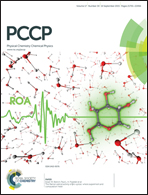Soft X-ray absorption spectroscopy of Ar2 and ArNe dimers and small Ar clusters†
Abstract
The X-ray absorption spectra (XAS) of Ar2 and ArNe dimers and small Ar clusters in the L2,3 region (244–252 eV) of the Ar atom have been recorded using synchrotron light and a combination of coincidence methods and kinetic energy discrimination of energetic ions. The absorption peaks in the spectra of the dimers and clusters were found to be shifted and broadened relative to the peaks in the spectrum of the Ar atom. In order to unambiguously relate these chemical shifts to the electronic structure of the core excited states in dimers, we performed ab initio calculations of the XAS spectra. Implications of the results for the use of XAS as a structure determination method in large rare gas clusters are discussed.


 Please wait while we load your content...
Please wait while we load your content...